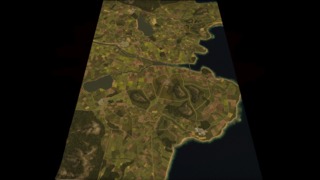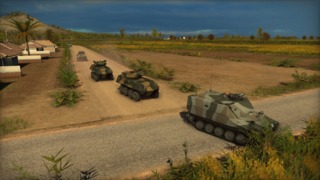Overview
The third entry in the Wargame series of real time tactical games by Eugen Systems, after the inclusion of planes in Wargame: Airland Battle, Red Dragon introduces navies and a host of other new features to the experience.
The Cold War time frame has also been extended; AirLand Battle featured a conflict from 1975 to 1985, while Red Dragon opens the window all the way to 1991. The focus of the action is now in Asia, and the game contains locales from the China-Russia border to the Korean Peninsula .
The deck-building system for customized forces returns, with several major improvements to accommodate both naval assets and new weapons developed in the 1990s. This is combined with a multiplayer mode which allows up to twenty players to fight in 10-versus-10 battles online.
Other features include:
- A new version of the IRISZOOM Engine including new water, lighting, and cratering effects.
- 12 single player campaigns from a variety of perspectives.
- Over 1200 units across 17 different national militaries.
- New game modes, such as Naval Battles.
- All-new maps, both larger in size and more detailed than before.
- New game mechanics such as amphibious units capable of crossing water.
Features

Red Dragon includes 5 new countries for use in both the campaign and multiplayer; previous countries included in Wargame: AirLand Battle will still be usable in Red Dragon's multiplayer. The new nations include:
REDFOR:
- People's Republic of China: After the Sino-Soviet split of the 1950s, China developed a local arms industry and by the 1990s had a military with a combination of western and eastern technology.
- North Korea: The DPRK military, kept constantly at vast troop levels, has developed an unusual set of armaments ranging from WW2 to modern while supported by the USSR and China.
BLUFOR:
- Japan: Combining US military hardware with a wholly domestic and defensive arms industry, Japan favors mechanized counter-offensives over striking deep into enemy territory.
- South Korea: At war since 1950, major fighting with the north ended in 1953 and South Korea remains in a state of constant readiness with solid infantry and US-inspired military vehicles.
- Australia/New Zealand: The Australia And New Zealand Army Corps (ANZAC) is a rapid-reaction force with high-mobility; its specialized units are dedicated to close combat and infantry warfare.

Coalitions are a new addition to Wargame's existing "Deck" system. The coalitions will be able to use each countries' prototype units but have less available activation points for units compared to purely national decks. The two nations stand alone - the USA and USSR - and are not included in any available coalitions due to their independent military strength. The coalitions are:
- The Commonwealth (United Kingdom, Canada, ANZAC)
- Eurocorps (France, West Germany)
- Scandinavia (Sweden, Denmark, Norway)
- Blue Dragons (Japan, South Korea)
- Non-Soviet Warsaw Pact (East Germany, Czechoslovakia and Poland)
- Red Dragons (China, North Korea)
All of the series' previous nations return for Red Dragon, many of which have new tools from the extended time frame into the 1990s.
BLUFOR:
- United States: The USA returns as the preeminent global military power, improving its arsenal with several new weapons from the 1990s including the M2A2 Bradley and the M1A2 main battle tank.
- France: France maintains a focus on relatively light units which emphasize speed over armor, and now boasts both the Leclerc main battle tank and the top-of-the-line Rafale fighter aircraft.
- United Kingdom: The UK, as the core of the British Commonwealth, improves its defensive power considerably with the heavily armoured Challenger 2 tank and the Typhoon fighter aircraft.
- Federal Republic of Germany: Continuing to build on its strengths, West Germany's Leopard 2A5 battle tank is one of the best in the world while the Tiger attack helicopter rains death from above.
- Sweden: Sweden receives no new units at the launch of Red Dragon, but more are promised in a later free DLC patch. They remain a powerful Scandinavian faction with diverse hardware.
- Canada: Canadian armor improves with the Leopard C2 and the Leopard C2 MEXAS, while the amphibious Bison troop transport can rapidly transport infantry anywhere on the battlefield.
- Norway: While they do not receive any new units in Red Dragon at release, Norwegian troops are especially effective in close combat and combine this strength with an effective air force.
- Denmark: Like other Scandinavian nations Denmark's new hardware is being added in a free DLC patch sometime after release. Their main focus is on strong and plentiful infantry forces.
REDFOR:
- Soviet Union: The USSR has continued building some of the best weapons and vehicles in the world including the versatile KA-52 helicopter, T-80UM battle tank, and the Udaloy-II warship.
- German Democratic Republic: East Germany does not have any '90s units at release, but instead relies on effective infantry and intelligence-gathering reconnaissance as it did in the past.
- Poland: Poland still uses a variety of unique pieces of equipment found nowhere else, along with a solid selection of infantry, but waits with other non-Soviet Warsaw pact nations for a '90s upgrade.
- Czechoslovakia: Like Poland and East Germany, Czechoslovakian equipment after 1985 will be added in a free DLC after release; they still have unique vehicles along with effective artillery.

Like the previous Wargame: European Escalation and Wargame: AirLand Battle units are detailed and often use several different weapons. Vehicles have different armor values facing in each direction, independently modeled optics, and fuel capacity that affects travel range.
Terrain continues to be a vital element of strategy. In addition to new visual and graphics upgrades, units can be concealed in behind hills, in forests, or with buildings. The IRISZOOM engine uses actual line-of-sight to determine if one unit can see another based on relative size and activity; shooting or moving can reveal a previously hidden target.

New to Red Dragon is the inclusion of amphibious unique which can ford rivers, lakes, and other bodies of water during battle. In towns, the upgraded urban combat interface from AirLand Battle is retained for infantry operations. As in previous entries, tracked vehicles are mobile on rough terrain while wheeled ones are fastest on roads and open ground.
When the shooting starts units aim, load, and fire their weapons in response to the enemy. This can be affected by their morale, which is also modeled in the game. The deck system now directly displays how experience affects units; rookies may be shaken by gunfire and panic, while experienced troops recover quickly from negative morale.
The critical effects of previous games return. Some of these are related to terrain, such as wheeled vehicles getting stuck, while others happen in battle such as hits on ammunition, optics, or the engine.

At sea, ships have devastating weapons and are supported by helicopters, fixed-wing aircraft, and amphibious troops. Vessels range from destroyers, such as the Soviet Sovremenny-class, to smaller missile ships and riverine boats for use inland. Naval units have countermeasures, and also defend themselves with close-in weapons systems (CIWS) against missile attack.
Both on land and at sea, ammunition and fuel are limited so supplying units is an important part of the game. Forward Operating Bases, supply trucks, naval tankers, and helicopters can be used to resupply a unit low on ammunition and fuel, or repair following damage from battle.
Log in to comment